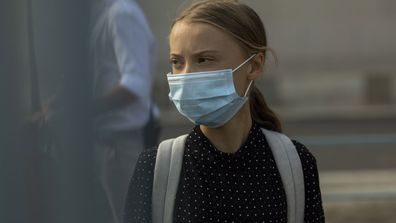Activists smash London bank HQ windows in Earth Day protest at coal investment
An activist from Extinction Rebellion smashes a window at HSBC headquarters during a protest in Canary Wharf, London. Reuters
Guy Faulconbridge
April 22 2021
Climate activists shattered at least 19 windows at HSBC's headquarters in London's Canary Wharf as part of a protest against the financing of what the group says is devastating climate change that threatens the planet.
The female activists from the Extinction Rebellion group used hammers to break the windows and pasted stickers on the windows before sitting down to wait for the police to arrive, a Reuters reporter at the scene said.
"Despite HSBC's pledge to shrink its carbon footprint to net zero by 2050, their current climate plan still allows the bank to finance coal power, and provides no basis to turn away clients or cancel contracts based on links to the fossil fuel industry," Extinction Rebellion said.
A spokesman for HSBC declined immediate comment.
Extinction Rebellion wants to trigger a wider revolt against the political, economic and social structures of the modern world to avert the worst scenarios of devastation outlined by scientists studying climate change.
"It's time to stand up and be counted," said Gully Bujak, 28, from Extinction Rebellion. "Doing this today may land us in prison but we're on the right side of history."
The activists referenced the struggle of the Suffragettes who used direct action to fight for votes for women in the early 20th Century.
The group broke windows at the London headquarters of Barclays two weeks ago.
Guy Faulconbridge
April 22 2021
Climate activists shattered at least 19 windows at HSBC's headquarters in London's Canary Wharf as part of a protest against the financing of what the group says is devastating climate change that threatens the planet.
The female activists from the Extinction Rebellion group used hammers to break the windows and pasted stickers on the windows before sitting down to wait for the police to arrive, a Reuters reporter at the scene said.
"Despite HSBC's pledge to shrink its carbon footprint to net zero by 2050, their current climate plan still allows the bank to finance coal power, and provides no basis to turn away clients or cancel contracts based on links to the fossil fuel industry," Extinction Rebellion said.
A spokesman for HSBC declined immediate comment.
Extinction Rebellion wants to trigger a wider revolt against the political, economic and social structures of the modern world to avert the worst scenarios of devastation outlined by scientists studying climate change.
"It's time to stand up and be counted," said Gully Bujak, 28, from Extinction Rebellion. "Doing this today may land us in prison but we're on the right side of history."
The activists referenced the struggle of the Suffragettes who used direct action to fight for votes for women in the early 20th Century.
The group broke windows at the London headquarters of Barclays two weeks ago.















